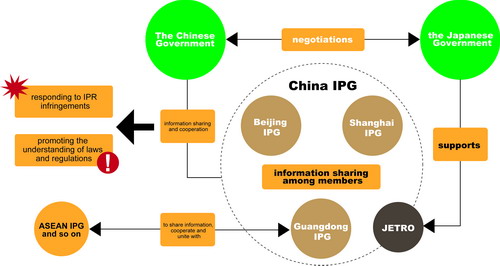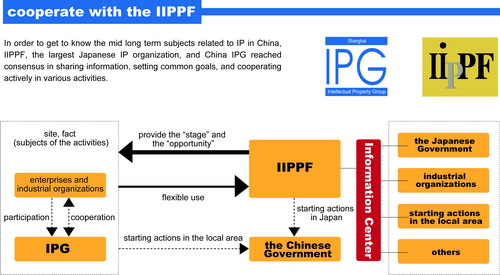The journalists of China IP often come across staff members of the Japan External Trade Organization (JETRO) in various activities concerning Japanese enterprises. JETRO has been dealing with IP related issues in China since 2000. During the last decade, its works of strengthening and promoting IP protection have adapted to keep in line with China's accession to the World Trade Organization (WTO). Therefore, JETRO is keenly aware of the changes in China's IP field which have taken place over the past decade.
In recent years, JETRO's efforts in China have become more and more intense, which is not only because the Chinese government, enterprises and related departments are attaching more importance to IP protection, but also due to the ever-rising Sino-Japanese trade development. According to the statistics JETRO released, in the first half of 2011, Japanese total foreign direct investment (FDI) reached 33.47 billion dollars, an increase of 63.1% compared to the same period last year. Among these FDIs, the investment in China alone reached 5.24 billion dollars, an increase of 113.2%, accounting for 15.6% of Japan's total FDI, second only to the United Kingdom, which was 6.01 billion dollars, accounting for 18% of the Japanese FDI. In the first half of the year, Japan's investment in Asia amounted to 13.57 billion dollars, an increase of 107.3% compared with the first half of last year, accounting for 40.5% of the total amount. Other major investment destinations besides China are Indonesia (1.76 billion dollars), Korea (1.18 billion dollars), Vietnam (1.17 billion dollars) and Thailand (1.12 billion dollars).
The past decade has seen JETRO's expansion of services along with the development of the legal construction, promotion of government functions and increase of enterprises' awareness in China's IP field. Compared to the situation in 2000, the JETRO staff must have a completely different feeling about carrying out their work in China.
 |
| JETRO |
The decade since China's accession in the WTO was also a critical decade for the development of China's IP protection. China IP conducted an interview at JETRO's headquarter in Japan to learn about the changes China has made in IP protection since joining the WTO and report on how these changes are perceived through their experiences.
China IP: JETRO has 73 overseas offices, and has established institutes in 7 cities in China. It is known that JETRO was established very early, but when exactly did it enter China? What work is it mainly responsible for in China?
JETRO: JETRO was established in 1958, and it set up the first representative office in Beijing in 1982. JETRO's Beijing Office was designed to provide support concerning IP protection and consulting services on labor and legal issues to Japanese enterprises who sought to expand their business in China. It served as a bridge for Sino-Japan commercial activities and also helped Chinese enterprises enter the Japanese market.
China IP: We know that a very important part of JETRO's work in China is related to IP protection, could you introduce the overall situation when JETRO first entered China and started IP protection work?
JETRO: It was after 2000 when JETRO actually started carrying out works concerning IP protection. At that time, we were almost at a loss when facing China's accumulating counterfeiting problems. According to the situation at that time, Japanese enterprises who were encountering similar problems united together and established an IP working group (IPG) which managed to share information through writing and sharing counter measures manuals against counterfeit products and holding lectures. In 2002, the first delegation for IP protection, which was composed of both governmental officials and individuals representing private enterprises, was sent to China.
 |
| Chart of JETRO |
China IP
: China joined the WTO in 2001, and the past decade has involved great changes in China in a variety of areas, including IP. How does JETRO evaluate these changes?
JETRO: During the last decade, JETRO combined its efforts with the Japanese government and the members of IPG to continuously communicate and cooperate with the Chinese government through making a variety of proposals, such as how to handle counterfeiting problems and to protect patent rights. Through amendments of the law, judicial interpretation, law enforcement, and other measures, IP protection environment in China has been improved gradually. It is safe to say that JETRO, along with the Japanese government and the members of IPG, have made a great contribution to the development of China's IP protection.
China IP: China has developed significantly since joining the WTO. Has JETRO ever modified its service direction accordingly? Could you provide a brief summary of any changes?
JETRO: When China joined the WTO, officers of the representative office of JETRO in Beijing visited China's competent IP departments on behalf of the IPG department of Japanese Chamber of Commerce and Industry in China. It spared no effort in describing the situation for them and enlightening the Chinese government of the practical situation of China's IP field. Related Chinese authorities held a very cooperative attitude towards these active promotions. Through repeated communications, joint actions based on the joint effort of both sides became feasible. For example, JETRO not only provided the Chinese law enforcement departments with information about how to identify counterfeit goods, but also took advantage of the opportunity to hold related training courses for law enforcement officials across the country. Japanese enterprises participated actively in these courses and made presentations to Chinese officials in order to deepen mutual understanding. Moreover, the largest non-governmental IPG, the International Intellectual Property Protection Forum (IIPPF), and the Japanese government kept on exchanging views with the Chinese government to ensure that the frontline problems could be accurately conveyed. We can say that it is through these measures that we nurtured the soil for “dialogue” with the Chinese government.
 |
| Chart of JETRO |
China IP
: As China's economy develops, especially during the decade after China joined the WTO, more and more enterprises entered China, what are the major changes in the development of those Japanese enterprises which entered the Chinese market? What are the major changes in IP development compared to ten years ago?
JETRO: When China first joined the WTO most Japanese enterprises had no idea of how to deal with IP problems in China; they were kind of groping about in the dark. However, the situation has changed as their cooperation with the Chinese government deepens and more and more legal professionals in IP field arrived in local areas. Japanese enterprises began to deal with IP problems on their own. Beijing IPG, Shanghai IPG and Guangdong IPG were set up respectively in 2000, 2002 and 2005, and began to conduct a variety of activities from then on.
China IP: Japanese enterprises which are developing in China often encounter various IP problems, including lawsuits. Therefore, it is also part of JETRO's works to provide professional consulting services to them. Today, mainly on what grounds are Japanese enterprises in China bringing Chinese enterprises to court? What are the major changes compared to years before? As far as we know, in China, there are much fewer lawsuits filed by Japanese enterprises than that of by American or European enterprises, why?
JETRO: How to combat counterfeit products is still the issue of most concern when it comes to IP protection in China. In recent years, not only the litigations brought up by Japanese right holders to protect their immediate interests, but also the litigations brought up by Chinese business entities against foreign enterprises are increasing. With the increase of patent applications in China, the number of lawsuits concerning IP also rises. As a result, how to deal with this situation has become an urgent issue. The reason why lawsuits filed by Japanese enterprises are relatively fewer lies mainly in that the risk awareness of IP litigation in China has not yet penetrated Japanese enterprises. Therefore, it is very necessary to establish a mechanism which attaches more importance on IP lawsuits by making Japanese enterprises understand the importance of possessing IP in China and defending their IP as one way of exerting IP rights.
China IP: In recent years, China has made amendments to its major laws related to IP, among which China's Patent Law has finished its third amendment; the Trademark Law and the Copyright Law have also started the amendment process. How does JETRO evaluate the legislative work China has done concerning IP protection from the perspective of a foreign organization?
JETRO: When the Patent Law was undergoing its third amendment, SIPO officials paid a visit to the Japan Patent Office (JPO) during their process of soliciting opinions from both home and abroad, and the amendments we have read have reflected the fact that they listened and considered those suggestions. That was a significant opportunity for Japanese right holders. At present, Japanese right holders are also paying special attention to the ongoing amendments of the Trademark Law and the Copyright Law, with the hope that Chinese authorities will deliberate on and take into consideration their views when soliciting public comments.
China IP: While improving the legislation, China has made many changes in a wide variety of areas to improve the various aspects of IP protection and to strengthen law enforcement. However, there are different views on the effect of these measures. How do Japanese-related organizations and enterprises in China view the effectiveness of these measures? What improvements do you think should be made in China?
JETRO: Some of the Japanese legitimate rights holders feel that the law enforcement in China lacks transparency and the procedure might not be legitimate. For instance, not all decisions made by the court are open to the public, and the judges may differ from one court to another. We have already made proposals to the Chinese government through intergovernmental negotiations and the White Papers on China's Economy and Japanese Enterprises 2010 published by the Japanese Chamber of Commerce and Industry in China.
In May 2000, IPG of Japanese Chamber of Commerce and Industry in China (Beijing IPG) set up
In December 2001, China joined the WTO
In September 2002, Shanghai IPG set up
In March 2004, Beijing IPG made and published Countermeasures Manuals against Counterfeit Products and IP Infringements for Japanese Enterprises
In May 2004, The second IP Protection Delegation of Officials and Civilians visited China
In June 2005, The third IP Protection Delegation of Officials and Civilians visited China
In August 2005, Guangdong IPG set up
In December 2005, Countermeasures Manuals against Counterfeit Products and IP Infringements for Japanese Enterprises (Revised) published
In June 2006, The fourth IP Protection Delegation of Officials and Civilians visited China
In September 2007, The fifth IP Protection Delegation of Officials and Civilians visited China
In August 2007, IPG's first R & D Study Tour
In April 2008, IPG Best Practice Award held for the first time
In February 2009, The sixth IP Protection Delegation of Officials and Civilians visited China
In August 2009, The Japanese Ministry of Economy and State Administration for Industry & Commerce of the People's Republic concluded a memorandum on cooperation in protection of intellectual property
In March 2010, Japanese Chamber of Commerce and Industry in China wrote the White Papers on China's Economy and Japanese Enterprises 2010 and delivered it to the various relevant Chinese governmental departments
In March 2010, The Japan Agency for Cultural Affairs and the Chinese National Copyright Administration concluded a memorandum of strategic cooperation on copyright and copyright related adjacent rights
(Translated by Monica Zhang)



